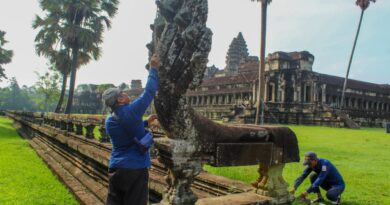រដូវវស្សាជារដូវដែលមានភ្លៀងធ្លាក់ធ្វើឱ្យរុក្ខជាតិតូចធំដុះយ៉ាងស្រស់បំព្រង តែរុក្ខជាតិទាំងនោះក៏មានផលប៉ះពាល់ខ្លះៗដែរ ដូច្នេះ អាជ្ញាធរជាតិអប្សរាតែងតែធ្វើការសម្អាតស្មៅ និងរុក្ខជាតិតូចៗដែលដុះនៅលើប្រាសាទជាប្រចាំ ដើម្បីរក្សាសោភ័ណភាព ការពារកុំឱ្យស្មៅ និងរុក្ខជាតិទាំងនោះបំផ្លាញភាពស្រស់ស្អាត។ ចំណែកឯ ឫសរបស់វាក៏បង្កឱ្យខូចខាតដល់ថ្ម និងរចនាសម្ពន្ធប្រាសាទផ្សេងៗជាច្រើនទៀតរបស់ប្រាសាទដែរ នេះបើយោងតាមប្រសាសន៍របស់លោក ងិន ធី ប្រធានកម្មករផ្នែកសម្អាតប្រាសាទ។
លោកបានបន្តទៀតថា ការសម្អាតនេះ ធ្វើឡើងជាញឹកញាប់ជាងគេ គឺនៅរដូវវស្សា ព្រោះមានភ្លៀងធ្លាក់ងាយធ្វើឱ្យរុក្ខជាតិតូចៗ និងស្មៅដុះលឿន។ រីឯ បច្ចេកទេសក្នុងការសម្អាតតាមប្រាសាទធ្វើឡើងដោយមានជណ្ដើរ មួកសុវត្ថិភាពក្នុងការរក្សាសុវត្ថិភាពពេលឡើងទៅលើកំពូលប្រាសាទឬផ្នែកផ្សេងៗ ដើម្បីដកស្មៅនិងកូនរុក្ខជាតិតូចៗ៕
អត្ថបទ៖ ឆាយ ផាន់នី
រូបភាព៖ យី សុថា/ ភោគ ជា
Activities to clean grass and small plants at Ta Prohm temple
The rainy season is the rainy season, making small and large plants grow beautifully, but those plants also have some bad effects. Hence, the APSARA National Authority regularly cleans the grass and small plants that grow on the temple to maintain its beauty. Its roots also cause damage to the stones and other structures of the temple, according to Ngin Thi, head of the temple’s cleaning team.
He added that the cleaning is most often done during the rainy season because it makes small plants and weeds grow faster. Cleaning the temple is done with a ladder and the team wears helmets to keep safe when going up to the top of the temple or other parts to remove weeds and small plants.
Article: Chhay Phanny
Photos: Yi Sotha / Phouk Chea
Share:
Our Latest News

អាជ្ញាធរជាតិអប្សរា ធ្វើសម្រង់ប្លង់បង្កាន់ដៃនាគជុំវិញប្រាសាទអង្គរវត្ត -APSARA National Authority prepares the risk map of the Naga balustrades around Angkor Wat - 24 June 2025
ក្រុមអ្នកបច្ចេកទេសផ្នែកអភិរក្សថ្ម នៃអាជ្ញាធរជាតិអប្សរា ធ្វើការងារសម្រង់ប្លង់បង្កាន់ដៃនាគនៅខឿនជាន់ទី១ជុំវិញប្រាសាទអង្គរវត្ត ដើម្បីសិក្សានូវចំណុចហានិភ័យនៃរចនាសម្ពន្ធបង្កាន់ដៃនាគ មុននឹងឈានទៅដល់ការជួសជុលឱ្យរឹងមាំឡើងវិញ។




